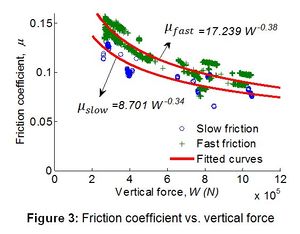Velocity and Normal Force Dependent Friction: Difference between revisions
No edit summary |
No edit summary |
||
| Line 55: | Line 55: | ||
---- | |||
SPECIAL CASES: | |||
1. Constant friction coefficient: | 1. Constant friction coefficient: | ||
Revision as of 19:12, 18 September 2014
- Command_Manual
- Tcl Commands
- Modeling_Commands
- model
- uniaxialMaterial
- ndMaterial
- frictionModel
- section
- geometricTransf
- element
- node
- sp commands
- mp commands
- timeSeries
- pattern
- mass
- block commands
- region
- rayleigh
- Analysis Commands
- Output Commands
- Misc Commands
- DataBase Commands
This command is used to construct a VelNormalFrcDep friction model object.
| frictionModel VelNormalFrcDep $frnTag $aSlow $nSlow $aFast $nFast $alpha0 $alpha1 $alpha2 $maxMuFact |
| $frnTag | unique friction model object tag |
| $aSlow | constant for coefficient of friction at low velocity |
| $nSlow | exponent for coefficient of friction at low velocity |
| $aFast | constant for coefficient of friction at high velocity |
| $nFast | exponent for coefficient of friction at high velocity |
| $alpha0 | constant rate parameter coefficient |
| $alpha1 | linear rate parameter coefficient |
| $alpha2 | quadratic rate parameter coefficient |
| $maxMuFact | factor for determining the maximum coefficient of friction. This value prevents the friction coefficient from exceeding an unrealistic maximum value when the normal force becomes very small. The maximum friction coefficient is determined from μFast, for example μ ≤ $maxMuFac*μFast. |
The friction model is defined as follows:
1. Define the friction coefficient at slow (μSlow) and fast (μFast) velocity [1] (Figure 3):
- μSlow = aSlow*N^(nSlow-1)
- μFast = aFast*N^(nFast-1)
where aSlow, aFast, nSlow ≤ 1, nFast ≤ 1 are constants that determine the friction coefficient models. As the friction coefficients μSlow and μFast are unitless, the user must be careful to define the constants to coincide with the units of the model input data.
2. The friction coefficient as a function of velocity is [2]:
- μ = μFast - (μFast-μSlow )*exp(-a*udot)
where udot is the velocity at the sliding interface and a is a rate parameter.
3. In this friction model, a is assumed to be dependent on axial force N through:
- a = α0 + α1*N + α2*N^2
where α0, α1 and α2 are constants, with units of Time/Length, Time/Length/Force and Time/Length/Force^2 respectively.

SPECIAL CASES:
1. Constant friction coefficient:
- μ = const: $nSlow = $nFast = 1.0; $aSlow = $aFast = μ; all other constants defining μ are arbitrary.
2. Friction coefficient varies with velocity but is independent of vertical force:
- μ is independent of vertical force: $nSlow = $nFast = 1.0; $alpha0 = a (rate parameter); $alpha1 = $alpha2 = 0.
3. Friction coefficient varies with vertical force but is independent of velocity:
- μ is independent of velocity: $nSlow = $nFast; $aSlow = $aFast; all other constants defining μ are arbitrary.
EXAMPLE:
set muSlow 0.12
set muFast 0.18
set nSlow 0.8
set nFast 0.7
set alpha0 25.0
set alpha1 0.0
set alpha2 0.0
frictionModel VelNormalFrcDep 1 [expr $muSlow/pow($W,$nSlow-1.0)] $nSlow [expr $muFast/pow($W,$nFast-1.0)] $nFast $alpha0 $alpha1 $alpha2 3.0
REFERENCES:
[1] Bowden F.P., Tabor D. (1964). "The friction and lubrication of solids – part II." Oxford University Press, London, Great Britain, 1964.
[2] Constantinou M.C., Mokha A., Reinhorn A. (1990). "Teflon bearings in base isolation. II: Modeling." Journal of Structural Engineering (ASCE) 1990; 116(2): 455-474
RELATED TO:
- Flat Slider Bearing Element
- Single Friction Pendulum Bearing Element
- Triple Friction Pendulum Bearing Element
Code Developed by: Nhan D. Dao, University of Nevada - Reno. E-mail: nhan.unr@gmail.com